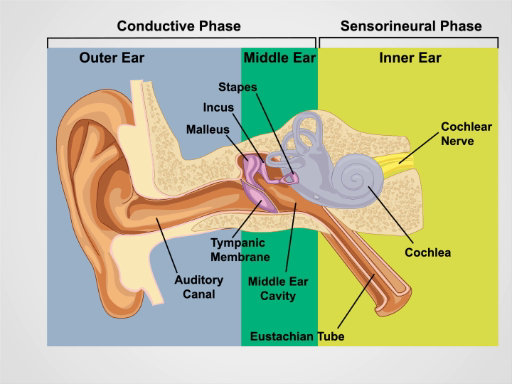Untersuchung der Ohren
Überblick
Quelle: Richard Glickman-Simon, MD, Assistant Professor, Department of Public Health and Community Medicine Tufts University School of Medicine, MA
Dieses Video beschreibt die Untersuchung des Ohres, beginnend mit einem Überblick über seine Oberfläche und innere Anatomie (Abbildung 1). Die knorpelige Ohrmuschel besteht aus der Helix, Anthelixfalte, Ohrläppchen und Tragus. Während des Warzenfortsatzes befindet sich direkt hinter dem Ohrläppchen. Die leicht geschwungene auditiven Kanal endet am Trommelfell, die Schallwellen gesammelt durch die Ohrmuschel, die luftgefüllten Mittelohr überträgt. Die Eustachische Röhre verbindet das Mittelohr mit dem Nasenrachenraum. Schwingungen der das Trommelfell übertragen, die drei verbundenen Gehörknöchelchen des Mittelohrs (Malleus, Incus und Stapes). Die Schwingungen werden umgewandelt in elektrische Signale im Innenohr und dann an das Gehirn durch Nervus Cochlear getragen. Hören, umfasst daher eine leitfähige Phase, die die Außen- und Mittelohr beinhaltet und eine sensorineurale Phase, die das Innenohr und Cochlear Nerven beinhaltet.
Den Gehörgang und das Trommelfell mit Otoskop, ein Handheld-Instrument mit einer Lichtquelle, eine Lupe und ein Einweg-kegelförmige Spekulum untersucht. Es ist wichtig, mit dem Trommelfell Sehenswürdigkeiten (Abbildung 2) vertraut sein. Nur zwei der drei Gehörknöchelchen - Malleus und Incus - kann normalerweise gesehen werden; der Malleus ist nahe dem Zentrum und der Uncus ist nur posterior. Ein Lichtkegel kann gesehen werden, nach unten und vorn von der Umbo oder Kontaktpunkt zwischen der Membran und der Spitze der Malleus ausgeht. Kurze Prozess etwa die Grenze zwischen den beiden Regionen das Trommelfell abgrenzt: der Pars Flaccida, überlegen und posterior, liegen und den weit größeren Pars Tensa, liegen anterior und inferior. Normalerweise ist das Trommelfell rosa-grau in Farbe und leicht reflektiert das Licht von dem Otoskop.

Abbildung 1: Anatomie des Ohrs. Eine schematische Zeichnung des menschlichen Ohres Frontalschnitt mit äußeren, mittleren und Innenohr Strukturen gekennzeichnet.
Verfahren
1. Ohr-Prüfung und Verhandlung
- Überprüfen Sie die Ohrmuscheln und das umgebende Gewebe für Veränderungen der Haut, Knötchen und Missbildungen.
- Greifen Sie die Helix souverän zwischen Daumen und Zeigefinger eine zu einem Zeitpunkt und ziehen Sie oben und rückwärts für Beschwerden überall in der Ohrmuschel zu überprüfen.
- Ertasten Sie den Tragus und Warzenfortsatzes Prozess für Zärtlichkeit.
- Führen Sie die geflüsterte Stimme Test für auditive Schärfe.
- Stellen Sie sicher, d
Anwendung und Zusammenfassung
Korrekte Auswertung des Ohres erfordert einen Hörtest und otoscopic Prüfung. Schallleitungsschwerhörigkeit entsteht durch Störungen der Außen- und Mittelohr. Ohrenschmalz Impaktion, Otitis Externa, Trauma, Fremdkörper und (seltener) Exostosen können zu Hörverlust führen, durch den Gehörgang zu behindern. Mittelohr Ursachen von Hörverlust, Otitis Media, Ohrtrompete Dysfunktion, Barotrauma und Otosklerose enthalten. Neurosensorische Schwerhörigkeit ist aufgrund von Erkrankungen des Innenohrs. Presbyakusis und L...
pringen zu...
Videos aus dieser Sammlung:

Now Playing
Untersuchung der Ohren
Physical Examinations II
55.2K Ansichten

Augenuntersuchung
Physical Examinations II
77.2K Ansichten

Ophthalmoskopie
Physical Examinations II
68.0K Ansichten

Untersuchung der Nase, Nebenhöhlen, Mundhöhle und Rachen
Physical Examinations II
65.8K Ansichten

Untersuchung der Schilddrüse
Physical Examinations II
105.1K Ansichten

Überprüfung der Lymphknoten
Physical Examinations II
387.7K Ansichten

Abdominaluntersuchung I: Inspektion und Auskultation
Physical Examinations II
202.8K Ansichten

Abdominaluntersuchung III: Palpation
Physical Examinations II
248.3K Ansichten

Abdominal-Prüfung III: Palpation
Physical Examinations II
138.6K Ansichten

Abdominaluntersuchung IV: Beurteilung akuter abdominaler Schmerzen
Physical Examinations II
67.3K Ansichten

Männliche Rektaluntersuchung
Physical Examinations II
114.6K Ansichten

Umfassende Brustuntersuchung
Physical Examinations II
87.7K Ansichten

Gynäkologische Untersuchung I: Beurteilung der äußeren Genitalien
Physical Examinations II
307.4K Ansichten

Gynäkologische Untersuchung II: Spekulumuntersuchung
Physical Examinations II
150.5K Ansichten

Gynäkologische Untersuchung III: Bimanuelle und rektovaginale Untersuchung
Physical Examinations II
147.8K Ansichten
Copyright © 2025 MyJoVE Corporation. Alle Rechte vorbehalten